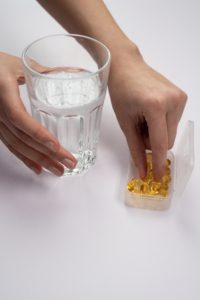Written by Harold Oster, MD. Results show that men and women with vitamin D deficiency had higher hemoglobin A1C levels (a measure of elevated glucose). In women, vitamin D levels were inversely associated with HbA1c, body mass index, and a marker for inflammation.
 Vitamin D deficiency, defined as a serum level of 25(OH)D below 20 ng/ml, is becoming increasingly common worldwide, with prevalence levels as high as 40% in Europe1. Vitamin D deficiency increases the risk of bone loss and fractures2 and has been associated with elevated glucose levels and diabetes3, obesity4, and inflammation5.
Vitamin D deficiency, defined as a serum level of 25(OH)D below 20 ng/ml, is becoming increasingly common worldwide, with prevalence levels as high as 40% in Europe1. Vitamin D deficiency increases the risk of bone loss and fractures2 and has been associated with elevated glucose levels and diabetes3, obesity4, and inflammation5.
Ji Hyun Lee, et al. studied the association of vitamin D levels and several clinical parameters, including hemoglobin A1C (HbA1C), muscle mass, body mass index (BMI), and inflammatory markers. Based on defined inclusion criteria, 290 men and 125 women were selected from a cohort of patients over fifty years old who visited an endocrinology clinic in Seoul, Korea. The participants completed surveys evaluating medical history, smoking, alcohol use, vitamin D supplementation, exercise, and other possible covariates. Weight and height were measured to calculate BMI. Fat and lean body mass were evaluated by bio-electrical impedance analysis6, strength was tested by handgrip, and performance was tested with the five-times chair stand test—the time it takes to stand from a chair five times7. Serum was tested for 25(OH)D, glucose, HbA1C, creatinine, and the inflammatory markers TNF-a, IL-6, and IL-1b.
The authors noted the following:
- 5% of the men and 35.2% of the women had vitamin D deficiency (25[OH]D below 20 ng/ml).
- The mean serum vitamin D levels were 18.1 ng/mL in men and 25.1 ng/mL in women.
- Men with vitamin D deficiency (VDD) had higher fat mass and HbA1C levels than those without VDD.
- Men with VDD had decreased handgrip strength and performed worse on the chair standing test than those without VDD.
- Levels of inflammatory markers were not significantly different in men with VDD compared to men without VDD.
- Women with VDD had a higher BMI, HbA1C, TNF-a, and creatinine than those without VDD.
- Women without VDD were more likely to exercise three times or more per week.
- Vitamin D supplementation was more common in women and men without VDD.
- Correlation analyses revealed inverse relationships between 25(OH)D levels and HbA1c, BMI, and TNF-α concentrations in women. The inverse relationship persisted after adjusting for confounding variables. This correlation was not seen in men.
Results of the study suggest an inverse correlation between vitamin D levels and HbA1C, BMI, and TNFa in women. Men and women with vitamin D deficiency had higher levels of HbA1C compared to those without VDD. Limitations of the study include a cross-sectional rather than longitudinal design, the participants were chosen from a single location, and information on several confounding factors was not ascertained.
Source: Lee, Ji Hyun, Ye An Kim, Young Sik Kim, Young Lee, and Je Hyun Seo. “Association between Vitamin D Deficiency and Clinical Parameters in Men and Women Aged 50 Years or Older: A Cross-Sectional Cohort Study.” Nutrients 15, no. 13 (2023): 3043.
© 2023 by the authors. Licensee MDPI, Basel, Switzerland. This article is an open access article distributed under the terms and conditions of the Creative Commons
Attribution (CC BY) license (https://creativecommons.org/licenses/by/4.0/).
Click here to read the full text study.
Posted August 1, 2023.
Harold Oster, MD graduated from medical school in Miami, Florida in 1992 and moved to Minnesota in 2004. After more than 25 years of practicing Internal Medicine, he recently retired. Dr. Oster is especially interested in nutrition, weight management, and disease prevention. Visit his website at haroldoster.com.
References:
- Amrein K, Scherkl M, Hoffmann M, et al. Vitamin D deficiency 2.0: an update on the current status worldwide. Eur J Clin Nutr. Nov 2020;74(11):1498-1513. doi:10.1038/s41430-020-0558-y
- Lips P. Vitamin D deficiency and secondary hyperparathyroidism in the elderly: consequences for bone loss and fractures and therapeutic implications. Endocr Rev. Aug 2001;22(4):477-501. doi:10.1210/edrv.22.4.0437
- Farahmand MA, Daneshzad E, Fung TT, et al. What is the impact of vitamin D supplementation on glycemic control in people with type-2 diabetes: a systematic review and meta-analysis of randomized controlled trails. BMC Endocr Disord. Jan 16 2023;23(1):15. doi:10.1186/s12902-022-01209-x
- Vanlint S. Vitamin D and obesity. Nutrients. Mar 20 2013;5(3):949-56. doi:10.3390/nu5030949
- E LB, Ismailova A, Dimeloe S, Hewison M, White JH. Vitamin D and Immune Regulation: Antibacterial, Antiviral, Anti-Inflammatory. JBMR Plus. Jan 2021;5(1):e10405. doi:10.1002/jbm4.10405
- Ward LC, Müller MJ. Bioelectrical impedance analysis. Eur J Clin Nutr. Jan 2013;67 Suppl 1:S1. doi:10.1038/ejcn.2012.148
- Whitney SL, Wrisley DM, Marchetti GF, Gee MA, Redfern MS, Furman JM. Clinical measurement of sit-to-stand performance in people with balance disorders: validity of data for the Five-Times-Sit-to-Stand Test. Phys Ther. Oct 2005;85(10):1034-45.
